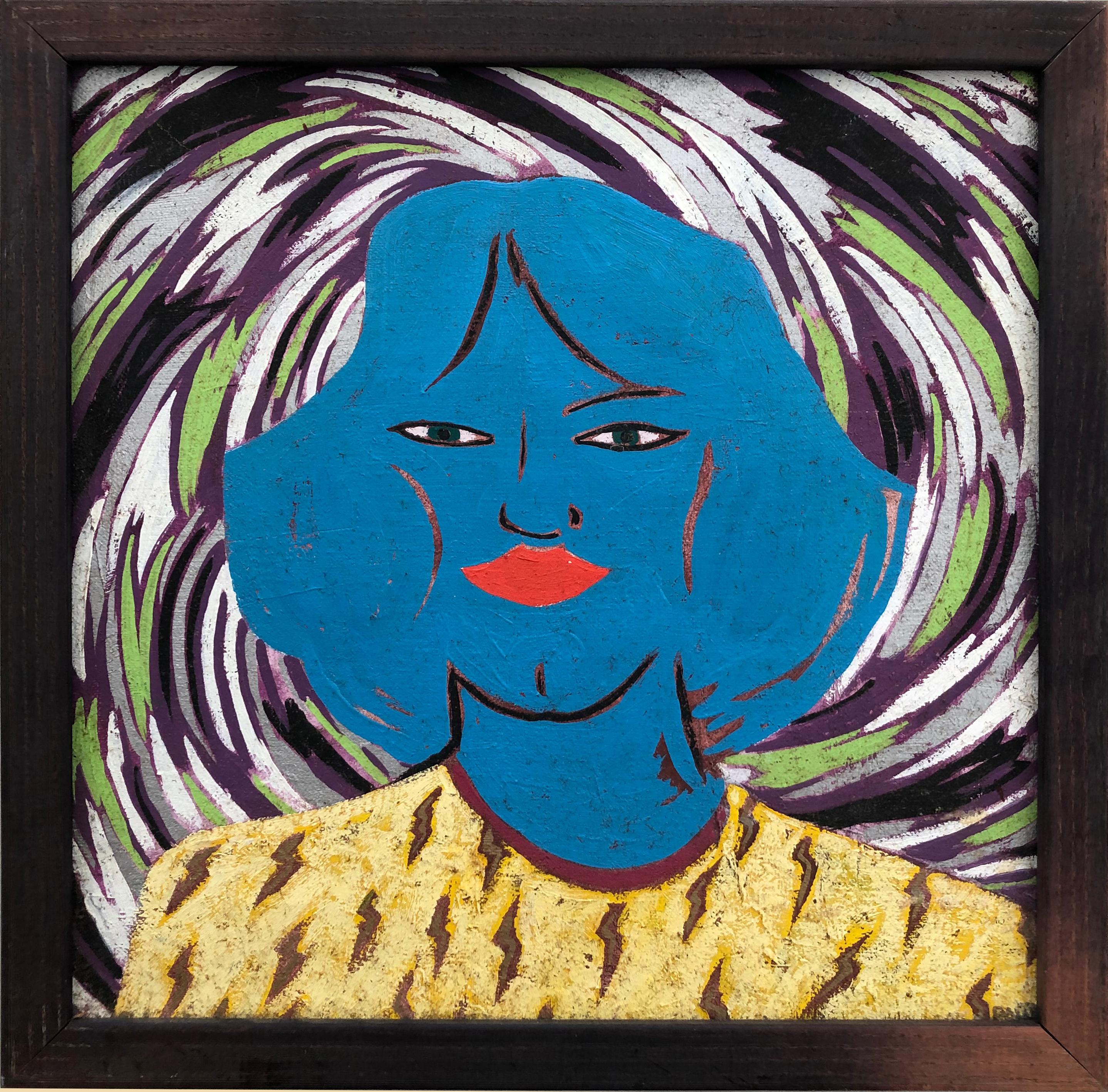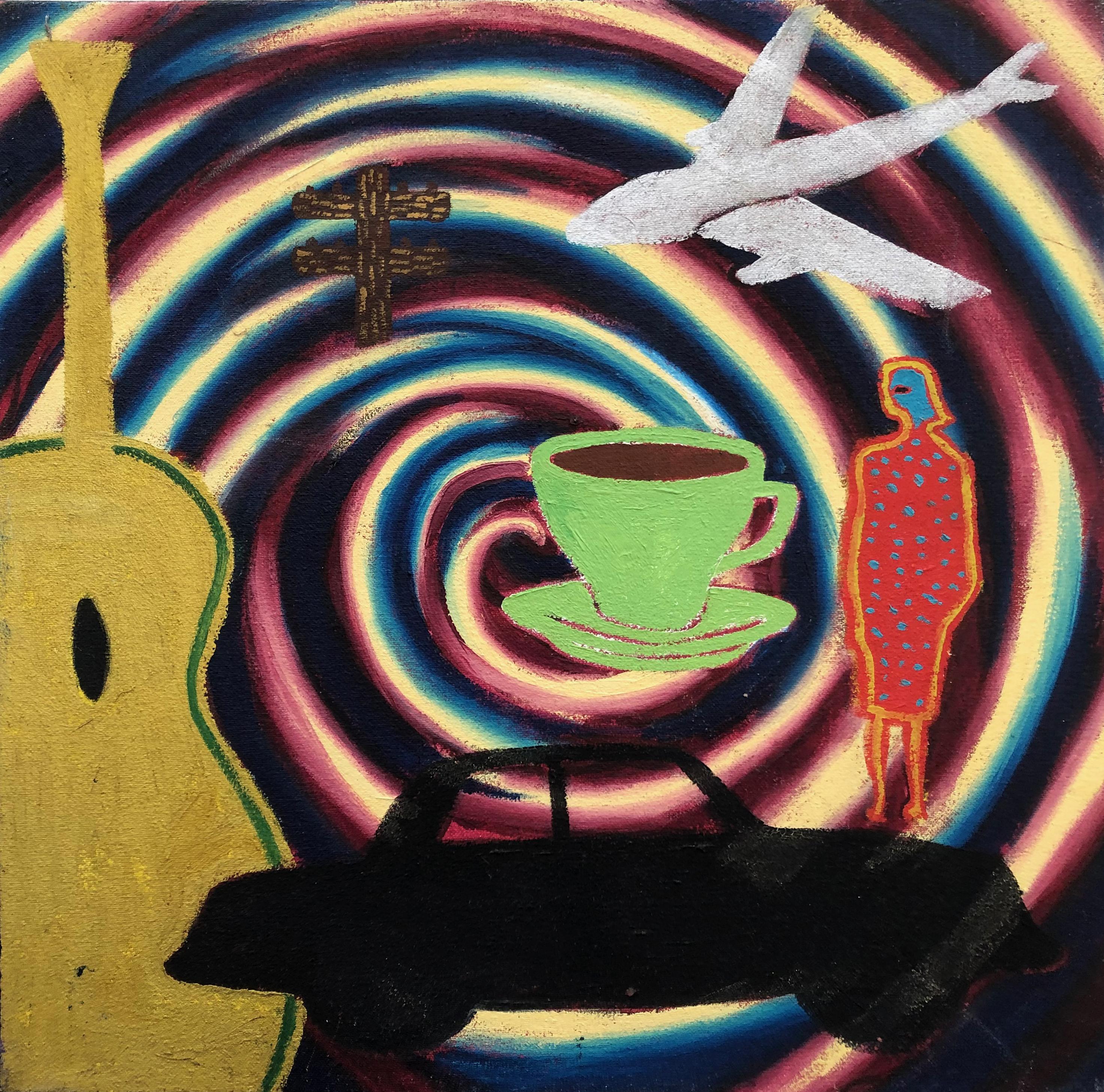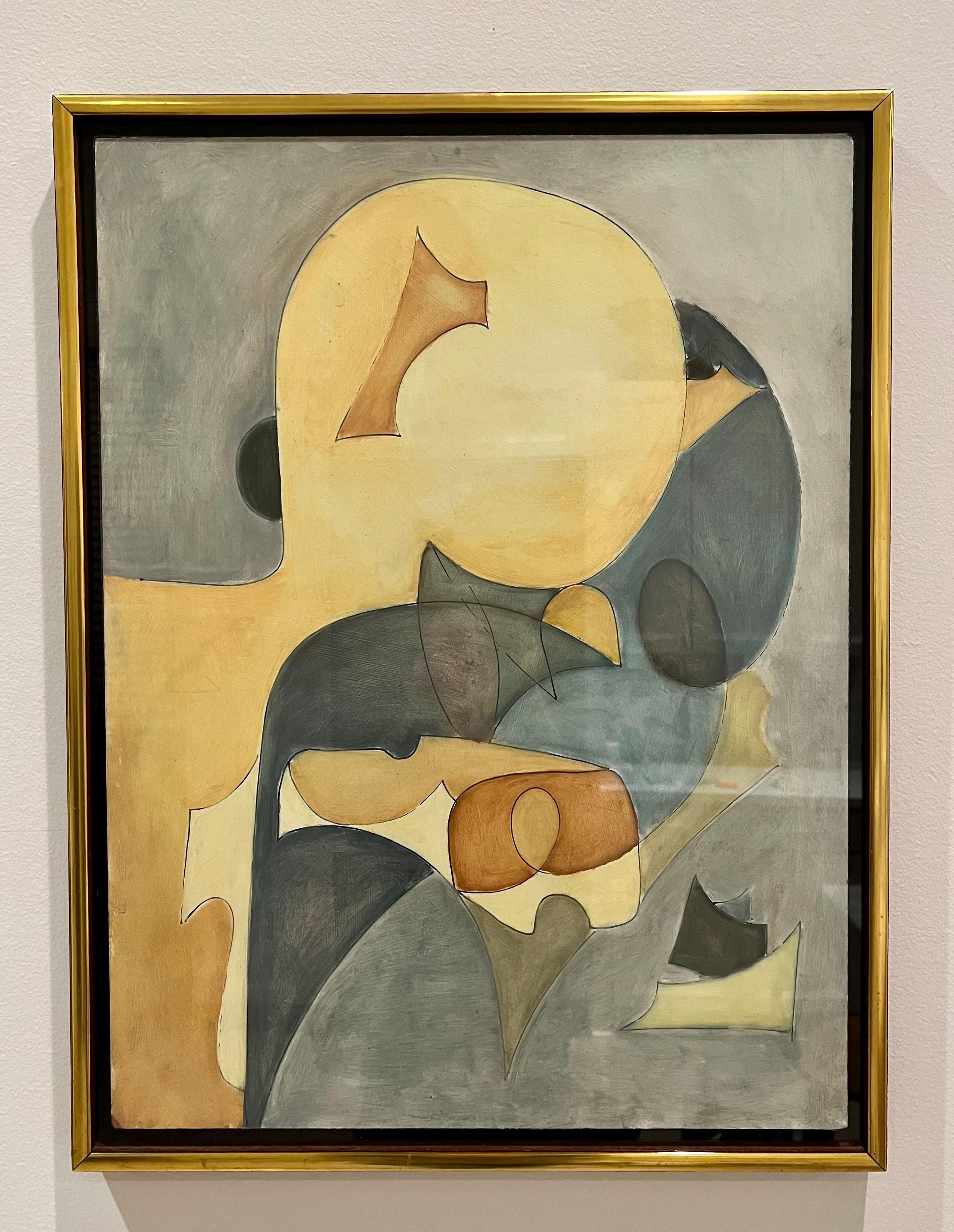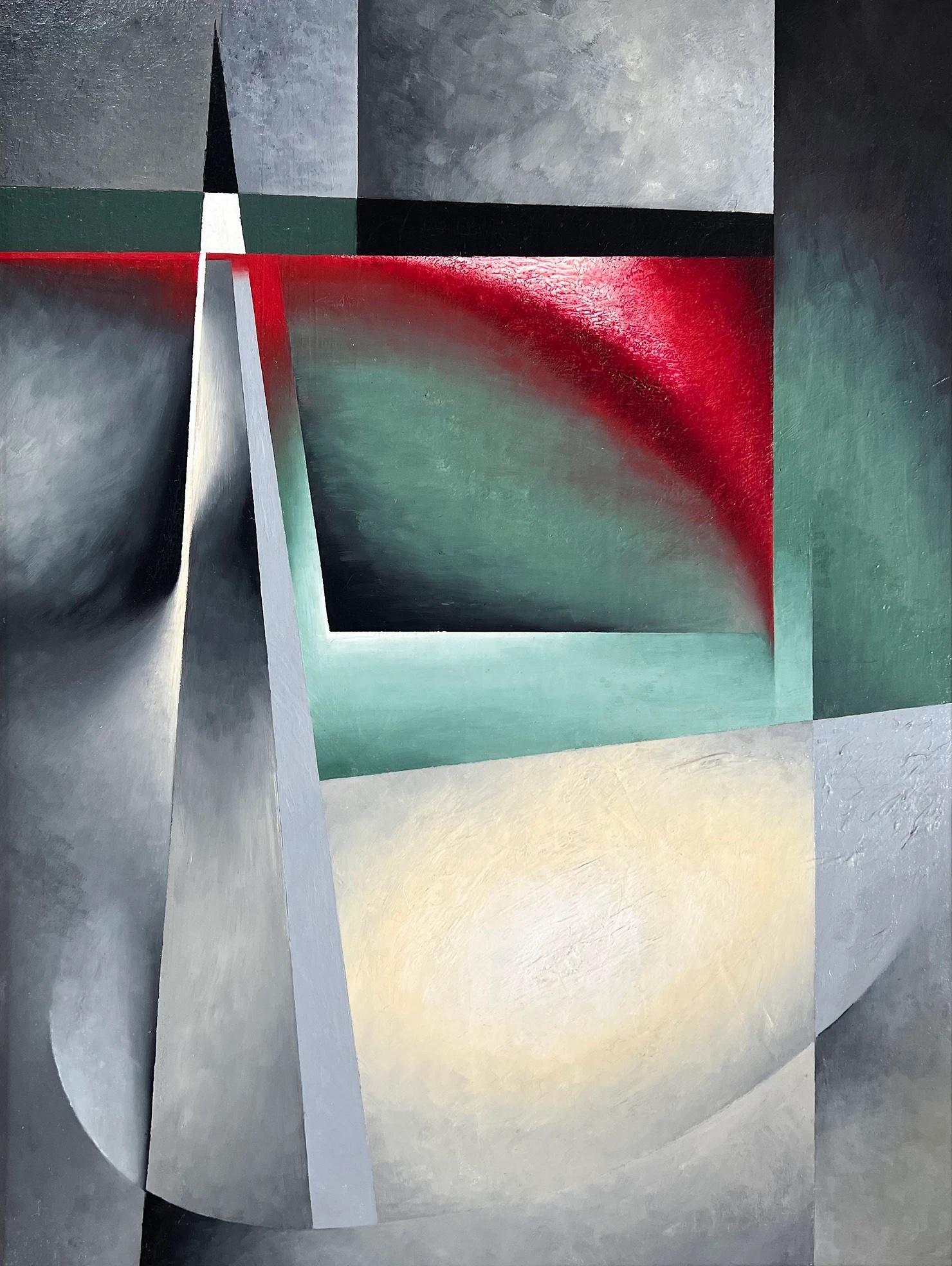Want more images or videos?
Request additional images or videos from the seller
1 of 6
FPA Francis Pavy ArtistACCORDIONIST WITH NIGHT FLOCK 1995
1995
About the Item
This work depicts a central figure with a blue face. A Turquoise violin-type shape is in the foreground. The figure is flanked by two areas of multi-colored briars that are Burning.
In the background, there is a flock of red birds flying in the night sky.
Signed on the reverse in Charcoal, it reads : Accordionist with night Flock( title) ©Francis X Pavy 1995 all rights reserved ( Signature date and copyright)
Message me for more questions about this work.
- Creator:FPA Francis Pavy Artist (1954, American)
- Creation Year:1995
- Dimensions:Height: 16 in (40.64 cm)Width: 16 in (40.64 cm)
- Medium:
- Movement & Style:
- Period:
- Condition:
- Gallery Location:Lafayette, LA
- Reference Number:1stDibs: LU1906210961002
About the Seller
5.0
Vetted Seller
These experienced sellers undergo a comprehensive evaluation by our team of in-house experts.
Established in 1982
1stDibs seller since 2022
8 sales on 1stDibs
- ShippingRetrieving quote...Ships From: Lafayette, LA
- Return PolicyA return for this item may be initiated within 14 days of delivery.
More From This SellerView All
- Swirling WomanBy FPA Francis Pavy ArtistLocated in Lafayette, LAThis small work depicts a Blue woman's figure with Red lipstick attired in yellow situated against a swirling purple, Green, black, and silver back ground. this work is framed. S...Category
1980s American Modern Abstract Paintings
MaterialsOil
- Sunset portraitsBy FPA Francis Pavy ArtistLocated in Lafayette, LAThis small painting is entitled Sunset Portraits. It's an oil painting on canvas mounted on wood. The painting depicts a man's silhouette formed by fl...Category
2010s American Modern Abstract Paintings
MaterialsOil
- Deep South TravelBy FPA Francis Pavy ArtistLocated in Lafayette, LAThis abstract work features several Pavy Design icons a waist a swirling red, yellow, and Deep blue Background. These Icons include a Coffee cup, Acoustic guitar, a telephone pole...Category
1990s American Modern Abstract Paintings
MaterialsOil
- Ahead of the Game - 14"x 16" oil on canvas paintingBy FPA Francis Pavy ArtistLocated in Lafayette, LAThis is an original oral painting by Francis X Pavy. Oil on canvas, 1996, 14" x 16" signed on the reverse. The painting depicts, two silhouettes of guitar shapes with a male and a fe...Category
1990s American Modern Abstract Paintings
MaterialsOil
- MIDNIGHT SECOND SUMMERBy FPA Francis Pavy ArtistLocated in Lafayette, LAThis is an original oil painting by Francis X Pavy. 20 by 26. 2016 Oil paint on canvas mounted on wood, signed on the obverse. About Francis X Pavy In the vast tapestry of the ar...Category
2010s American Modern Abstract Paintings
MaterialsOil
- Swamp StormBy FPA Francis Pavy ArtistLocated in Lafayette, LAThis small work is Entitled "swamp storm". It Measures 12" x 12" , and is oil on Cotton Duck canvas Signed on the reverse> in Charcoal on the reverse 1t reads : ©Francis x Pavy...Category
Early 2000s Modern Abstract Paintings
MaterialsOil
You May Also Like
- Moon Glow by Robert TerryLocated in Brookville, NYBorn 1955 in Broken Bow, Nebraska. Lives and works in New York. AWARDS National Endowment for the Arts, Major Grant Robert Terry was best noted in his depictions of romantic moons...Category
1990s American Modern Landscape Paintings
MaterialsOil
- American School, Abstract UntitledLocated in New Orleans, LAAmerican School, Artist UnknownCategory
Early 20th Century American Modern Abstract Paintings
MaterialsOil, Board
- AbstractLocated in Los Angeles, CAThis painting is part of our exhibition Charles Goeller: A Wistful Loneliness. Oil on canvas, 29 x 22 inches, Signed on frame verso “Painted by Charles L. Goeller” Exhibited: (Perh...Category
1930s American Modern Abstract Paintings
MaterialsOil
- Energy Manifestation #4Located in Los Angeles, CAEnergy Manifestation #4, 1933, oil on canvas, 24 x 30 inches, signed and dated lower left. Likely exhibited at Nicolaides’ solo show at the Wadsworth Atheneum (Morgan Memorial Building), Hartford, Connecticut, in April, 1933 (see Memorial Opens Varied Display of Nicolaides Work, Originality Distinguishes Creations of New York City Artist, Hartford Courant, April 5, 1933) About the Painting This rare work comes from Nicolaides’ energy series, which draws on a unique combination of machine- age aesthetics, Italian-influenced Futurism and French-inspired Surrealism. But, this is a uniquely American work produced in the melting pot of the 1930s metropolis, New York City. Nicolaides uses the ray lines of the American precisionists to frame a pulsating apparatus that unites man and machine as one. The cogs and gears of the fantasy machine seamlessly blend with the hand of its operator. We are left to wonder whether the two are working together in harmony or whether the worker has been absorbed into the machine, like a Depression era robot. In reviewing the 1933 Wadsworth Atheneum show, where works from Nicolaides’ energy series were exhibited, a critic described these paintings as “combining . . . highly imaginative form aspects of machinery and flashes of color which seem to represent light and heat.” The same critic praised the artist, “Mr. Nicolaides here achieves powerful effects with line, mass and color. These pictures are striking for the solidity of the objects portrayed, for their composition and for their delicate orchestration of tones.” Commenting on the same exhibition, Frederick Hynd, the director of the Hartford Art School, noted that “Mr. Nicolaides’ work was noteworthy for its extremely personal sense of color and for its imagination” and that the artist achieved decorative effects “based on emotional ideas.” About the Artist Kimon Nicolaides...Category
1930s American Modern Abstract Paintings
MaterialsOil
- Amish Farmscape #3By Edmund LewandowskiLocated in Los Angeles, CAAmish Farmscape #3, 1984, oil on canvas, 40 x 30 inches, signed and dated lower right; signed, dated, and titled verso About the Painting Amish Farmscape #3 is part of a multi-painting series of barns completed in the early 1980s for an exhibition at New York’s prestigious Sid Deutsch Gallery. Lewandowski painted this work at an important point in his career. It was the first major project undertaken by Lewandowski after his retirement from serving as the Chairman of Winthrop University’s Art Department, the last academic position he held after teaching for nearly thirty years. Lewandowski had been inspired to work on the series by a visit to Lancaster County, Pennsylvania. Like his friend and mentor, Charles Sheeler, Lewandowski had always been fascinated by vernacular architecture and the Amish barns of Pennsylvania brought back memories of rural scenes Lewandowski had painted in the Midwest much earlier in his career. Amish Farmscape #3 is a strong example of Lewandowski’s late precisionist work. The complexity of the composition and Lewandowski’s technical acumen are on full display. Being relieved of the burdens of teaching and administering a university art department likely allowed Lewandowski greater freedom and most importantly more time to complete the Amish Farmscape series. Although Lewandowski’s brand of precisionism changed throughout the years, he never deviated from the core tenets of the Immaculate School artists. In this work, we see simplified and flattened forms, the use of ray-lines to define light and space, the elimination of extraneous details, a polished almost machine-like finish, and the complete lack of visible brushstrokes, all hallmarks of the precisionist painters. Lewandowski was the last of the 20th century precisionists and in Amish Farmscape #3, we see just how successfully he continued to work in this style until his death in 1998. About the Artist Edmund Lewandowski was among the best of the second-generation precisionist painters. He was born and raised in Milwaukee, Wisconsin and studied at the Layton School of Art with Garrett Sinclair. Lewandowski achieved early success when in 1936 two of his watercolors were shown at the Phillips Collection as part of a Federal Art Project exhibition. Then, in 1937, his work was first exhibited at Edith Halpert’s Downtown Gallery which represented Lewandowski into the 1950s. Under Halpert’s guidance, Lewandowski continued to explore watercolor as his main medium during the 1930s and 1940s, since the gallery already represented Charles Sheeler, who worked primarily in oils. Sheeler became Lewandowski’s major influence as the primary leader of the ill-defined, but very recognizable Immaculate School artists, which included other Downtown Gallery painters, Niles Spencer, George Ault, and Ralston Crawford, as well as Charles Demuth and Preston Dickinson, both of whom died at a young age and had been represented by the Charles Daniel Gallery. Sheeler is credited with giving Lewandowski technical advice on how to make his paintings more precise and tightly rendered and by all accounts, Sheeler was a fan of Lewandowski’s work. Through the Downtown Gallery, Lewandowski’s paintings were accepted into major national and international exhibitions and purchased by significant museums and collectors. Franklin and Eleanor Roosevelt and Nelson Rockefeller acquired works by Lewandowski. He was included in the Museum of Modern Art’s important 1943 exhibition, American Realists and Magic Realists as well as juried exhibitions at the Whitney Museum of American Art, the Pennsylvania Academy of Fine Arts, and the Art Institute of Chicago. Lewandowski also completed commissions for magazines during the 1940s and 1950s, including several covers for Fortune. Throughout his career, Lewandowski explored urban and rural architecture, industry, machinery, and nautical themes. Looking back on his career, Lewandowski wrote, “My overwhelming desire as an artist through the years has been to record the beauty of man-made objects and energy of American industry on canvas. For as far back as I can recall, the cityscapes, farms and depictions of industrial power and technological efficiency has had a great attraction for me. I try to treat these observations with personal honesty and distill these impressions to a visual order.” Lewandowski is credited with extending precisionism to the Midwest and successfully continuing the style into the 1990s, three decades after Sheeler’s death and six decades after Demuth’s passing. Late in his career, Lewandowski enjoyed a resurgence of popularity as he was represented during the 1980s by New York’s Sid Deutsch and Allison Galleries...Category
Mid-20th Century American Modern Landscape Paintings
MaterialsCanvas, Oil
- The Magician oil and tempera painting by Julio de DiegoBy Julio de DiegoLocated in Hudson, NYJulio De Diego’s Atomic Series paintings made an extraordinary statement regarding the shock and fear that accompanied the dawn of the nuclear age. In the artist’s own words, “Scientists were working secretly to develop formidable powers taken from the mysterious depths of the earth - with the power to make the earth useless! Then, the EXPLOSION! . . . we entered the Atomic Age, and from there the neo-Atomic war begins. Explosions fell everywhere and man kept on fighting, discovering he could fight without flesh.” To execute these works, De Diego developed a technique of using tempera underpainting before applying layer upon layer of pigmented oil glazes. The result is paintings with surfaces which were described as “bonelike” in quality. The forms seem to float freely, creating a three-dimensional visual effect. In the 1954 book The Modern Renaissance in American Art, author Ralph Pearson summarizes the series as “a fantastic interpretation of a weighty theme. Perhaps it is well to let fantasy and irony appear to lighten the devastating impact. By inverse action, they may in fact increase its weight.” Exhibited 1964 Marion Koogler McNay Art Institute, San Antonio, Texas This work retains its original frame which measures 54" x 42" x 2" About this artist: Julio De Diego crafted a formidable persona within the artistic developments and political struggles of his time. The artist characterized his own work as “lyrical,” explaining, “through the years, the surrealists, the social-conscious painters and the others tried to adopt me, but I went my own way, good, bad or indifferent.” [1] His independence manifested early in life when de Diego left his parent’s home in Madrid, Spain, in adolescence following his father’s attempts to curtail his artistic aspirations. At the age of fifteen he held his first exhibition, set up within a gambling casino. He managed to acquire an apprenticeship in a studio producing scenery for Madrid’s operas, but moved from behind the curtains to the stage, trying his hand at acting and performing as an extra in the Ballet Russes’ Petrouchka with Nijinsky. He spent several years in the Spanish army, including a six-month stretch in the Rif War of 1920 in Northern Africa. His artistic career pushed ahead as he set off for Paris and became familiar with modernism’s forays into abstraction, surrealism, and cubism. The artist arrived in the U.S. in 1924 and settled in Chicago two years later. He established himself with a commission for the decoration of two chapels in St. Gregory’s Church. He also worked in fashion illustration, designed magazine covers and developed a popular laundry bag for the Hotel Sherman. De Diego began exhibiting through the Art Institute of Chicago in 1929, and participated in the annual Chicago Artists Exhibitions, Annual American Exhibitions, and International Water Color Exhibitions. He held a solo exhibition at the Art Institute of Chicago in the summer of 1935. Though the artist’s career was advancing, his family life had deteriorated. In 1932 his first marriage dissolved, and the couple’s young daughter Kiriki was sent to live with friend Paul Hoffman. De Diego continued to develop his artistic vocabulary with a growing interest in Mexican art. He traveled throughout the country acquainting himself with the works of muralists such as Carlos Merida, and also began a collection of small native artifacts...Category
1940s American Modern Abstract Paintings
MaterialsMasonite, Oil, Tempera





